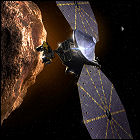 NASA launches the Lucy spacecraft on its twelve-year mission to study select specimens of the Trojan asteroid swarms that both precede and trail the planet Jupiter at the stable LaGrange points in its orbit. Lucy’s complex trajectory calls for it to conduct gravity assist flybys of Earth in 2022 and 2024, and to survey the main asteroid belt body 52246 Donaldjohanson in 2025, en route to reaching its first Trojan asteroid, 3548 Eurybates, in 2027. Future targets include 15094 Polymele later in 2027, 11351 Leucus and 21900 Orus in 2028, and – after a further gravity assist flyby of Earth in 2030 – the binary Trojan pair 617 Patroclus-Menoetius in 2033. Lucy’s name is not an abbreviation; it is named after a famous fossil skeleton discovered in 1971 by a team led by anthropologist David Johanson; it is hoped that studying the Trojan asteroids will lead to discoveries that make them similar “missing links” in the solar system’s own fossil record.
NASA launches the Lucy spacecraft on its twelve-year mission to study select specimens of the Trojan asteroid swarms that both precede and trail the planet Jupiter at the stable LaGrange points in its orbit. Lucy’s complex trajectory calls for it to conduct gravity assist flybys of Earth in 2022 and 2024, and to survey the main asteroid belt body 52246 Donaldjohanson in 2025, en route to reaching its first Trojan asteroid, 3548 Eurybates, in 2027. Future targets include 15094 Polymele later in 2027, 11351 Leucus and 21900 Orus in 2028, and – after a further gravity assist flyby of Earth in 2030 – the binary Trojan pair 617 Patroclus-Menoetius in 2033. Lucy’s name is not an abbreviation; it is named after a famous fossil skeleton discovered in 1971 by a team led by anthropologist David Johanson; it is hoped that studying the Trojan asteroids will lead to discoveries that make them similar “missing links” in the solar system’s own fossil record.
